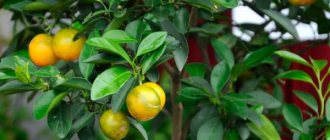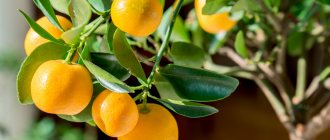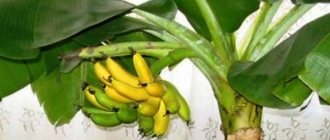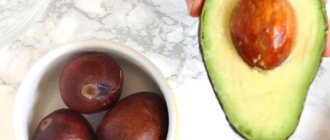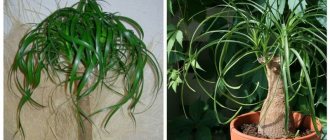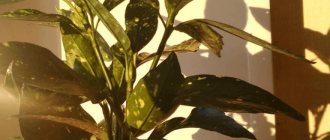It is thanks to them that the plant received the popular name “golden orange”. The small, fragrant fruits cover the crown abundantly and sometimes seem unreal. Therefore, novice gardeners have a question: “Is it possible to eat calamondin?”
The round fruits, with a thin zest and a juicy core, are edible. But you shouldn’t expect the sweetness of tangerine in this case. The pulp of yellow-orange calamondins is sour or even bitter, but the peel, like that of a kumquat, is sweetish and very aromatic.
Calamondin what is it
The cute potted plant Calamondin was created by crossing a tangerine and a kumquat. And if the tangerine is familiar to us from childhood, then the kumquat is a representative of citrus fruits that looks like a small, elongated tangerine.
Calamondin or citrofortunella adapts well and bears fruit at home. Calamodin varieties are hybrids that are adapted for growing at home. The plant belongs to the Rutov family. Characteristic features of calamondin:
- home tree up to 1.2 m in size (there are smaller, dwarf varieties);
- leaves are simple, with a glossy shine, oval in shape;
- large flower buds reach 2.5 cm;
- the calamondin flower resembles five-lobed “stars” that emit a pleasant citrus aroma;
- characterized by self-pollination and the formation of a large number of ovaries;
- domestic, small fruits (10-15 g) resemble round tangerines.
Calamondin begins to bear fruit 2-3 years after planting. Dwarf citrus forms a dome-shaped crown, abundantly covered with shiny foliage, between which orange fruits peek out.
The plant is native to Southeast Asia, where it grows naturally. In nature, the calamondina tree reaches 7 m in height and bears fruit abundantly all year round, supplying the local population with edible fruits.
Can calamondin fruits be eaten?
If a calamondin tree has just been purchased and is hung with orange tangerines, then it is better not to eat them. For decoration and protection from pests and diseases, calamondin undergoes repeated treatment with chemicals in greenhouses where it is grown for sale.
Home-ripened citrus fruits are quite edible. Calamondin mandarins have a specific, sweet and sour taste with a slight bitterness. Unfortunately, citrus fruits contain a lot of seeds and organic acids, so fruit experts recommend eating them directly with the peel.
It’s good if household members like this citrus taste: the number of homemade fruits allows you to enjoy them from time to time. Ripe tangerine fruits are cut from the branches and eaten, calamodin jam or other sweet dish is prepared, and stored in a cool place.
With proper care, citrus flowering and fruiting continues all year round. It’s a common thing when “white stars” bloom on a home tree at the same time and the orange balls of tangerines are pleasing to the eye. But there are certain varieties that bear fruit seasonally.
Possible problems
If calamondin is not properly cared for, problems may arise such as:
- Drying of branches and flying leaves . If the leaves fly away in autumn, then this is a completely natural process. If leaf shedding is observed at other times, this may be due to improper watering, poor lighting, or a violation of the temperature regime.
- Unripe fruits fly around . This happens when the earthen clod is dry or there is an acute lack of nutrients. In addition, the bush can drop fruits on its own if there are a lot of them.
- Lack of flowering . Too poor lighting. Move the bush to a suitable place or provide additional lighting. In some cases, the cause is a lack of moisture and nutrients.
Calamondin care at home
The exotic tree is perfect for “living” at home. Moreover, both experienced gardeners and beginners can grow calamondin. The combination of the visual attractiveness of citrus with unpretentiousness, high yield and edible fruits pleases and delights residents of middle and northern latitudes.
Soil and drainage
Two weeks after purchase, the calamondin plant needs to be transplanted “to a permanent place of residence.” Replanting a houseplant is easy using step-by-step instructions:
- Buy an earthen mixture for citrus fruits, which is a nutritious and loose substrate.
- For calamondin citrus, purchase a clay or wooden pot that is 3-4 cm in diameter larger than the original container. The diameter of the pot depends on the volume of the plant's root system. Plastic containers are also used, which provide good drainage.
- When transshipping, consider the condition of the citrus root system and remove dried and rotten roots.
- Remove the fruits and shorten the branches so that the citrus will take root better. The fruits of calamondin and the leafy ground part absorb nutrients, causing the fragile tree to get sick.
- Place drainage at the bottom of the pot. A 2-3 cm thick layer of expanded clay, pebbles and broken bricks will protect the root system from rotting. Citrus trees love moist soil, but stagnant water is detrimental to them.
- Drainage, a layer of soil, and the roots of the tree are placed in the pot in layers and covered with nutrient substrate. The soil is lightly compacted, leaving a distance of 3-5 cm from the edge of the pot for easy watering of homemade citrus.
- After transplantation, calamondin is watered and not fed for a month, since there are enough nutrients in the soil.
Sometimes after transplantation, calamondin sheds its leaves. This is a temporary phenomenon. With proper care, young shoots subsequently appear, the plant actively grows, restoring its appearance.
Lighting requirements
Citrofortunella calamondin feels good on the eastern and southeastern sides of the house, as well as on a balcony or loggia where there is diffused lighting. When placing near a south window, it is advisable to cover the glass with light-protective film. The domestic calamondin tree does not tolerate direct sunlight. This is especially noticeable in the heat, when brown spots from sunburn appear on citrus leaves.
Citrus will not bear fruit if daylight hours are significantly reduced. If the grower is committed to year-round fruiting of calamondin, then lighting is important so that daylight hours last 10-12 hours.
It is not advisable to frequently move the pot. The Citrofortunella tree is quite capricious in terms of habitat. It takes root in one place and does not tolerate change. To ensure uniform growth of shoots and a round crown, it is advisable to rotate homemade calamondin clockwise by 10-15 degrees per week.
Microclimate
For calamondin citrus, it is important to maintain the temperature in the range from +23 to +26C. There should be no strong differences between day and night temperatures. In winter, the optimal temperature is +12-+18C, if the houseplant is resting and does not bear fruit. After a period of dormancy, flowering and fruiting will be abundant.
Homemade citrofortunella does not like stagnant, “heavy” air. Ventilation is important, but without drafts and cold air currents. Reducing the temperature level to +2 - + 3C is dangerous for a tree called calamondin.
The temperature of the soil of the roots and the upper part of the citrus should be approximately the same. If the house has heated floors, then you need to lift the plant onto a stand. In summer, it is advisable to wrap the pot in white paper so that it does not overheat.
Watering and spraying
Since the domestic calamondin comes from the tropics, it is a big fan of humid climates. In order for the tree to feel good in the apartment, watering the plant is important:
- Watering is carried out constantly so that the earthen ball does not dry out.
- Use settled, “soft” water at room temperature.
- After watering, drain the water from the pan to avoid rotting of the roots.
- The plant is sprayed a couple of times a week with a spray bottle and, if possible, the leaves of the tree are wiped from dust.
- Central heating dries out the air greatly, so in the room with the home calamondin, they install humidifiers, put water in trays or containers, and hang wet towels on the radiators.
If a homemade citrus tree has dried out, it can not only shed all its leaves, but also die. Soil and environmental moisture is an important condition for the active life of a plant.
There are not so many varieties of calamondin, you can count them on your fingers. Among others, calamondin variegata with variegated foliage stands out. The milky spots look unusual against the background of bright green foliage. The Senteniel variety is a variegated variety. The varieties Meiva and Margarita have the most delicious fruits.
Feeding and fertilizers
From spring to autumn, during the active growing season, homemade calamondin needs additional nutrition. It is fed twice a month with complex formulations for citrus fruits. In winter, it is enough to fertilize the tree once a month. Foliar spraying of microfertilizers on the leaf is useful.
Homemade calamondin loves succinic acid supplements, but treatment with this drug must be carried out carefully, after reading the instructions. The plant is not indifferent to fertilizing based on banana peels. A combination of different ways to feed your homemade calamondin will definitely bear fruit. The citrus tree will delight the owner with abundant flowering and fruiting.
Crown formation
When the “pet” grows to 25 cm, the formation of a rounded crown begins to give the plant a well-groomed, neat appearance. Calamondin pruning is carried out from mid-February to mid-summer. Subsequence:
- First, the upper shoots are pruned;
- shorten the branches of the middle part;
- pinch the top when the calamondin has reached the desired height.
Pruning the main branches encourages side branch growth, which creates a fuller, leafier citrus canopy that doesn't have side branches sticking out. They also remove shoots that do not grow fruit for the second year in a row.
Hygienic pruning of home citrus is also important, which is carried out as needed. At the same time, dried, crooked branches that stand out from the overall symmetry are removed. The total increase should be no more than 30% per year.
To make homemade kalamodnin feel like it’s in the tropics and get sick less, they use the grafting method. A strong orange seedling is used as a rootstock. Calamondin grafting is carried out by an experienced grower with practical skills.
Flowering and dormant period
Homemade citrus looks the same throughout the year. There are varieties of kalamodin that consistently bear fruit all year round. Others require a period of rest or a period of rest in order to gain strength for active growth, flowering, and fruiting. The period of active life of citrus occurs in spring and summer.
It is advisable to move calamondin into a room with a temperature of up to +18C in the autumn. Diffused light, watering, and occasional fertilizing will help the houseplant prepare for the next growing season. And in the summer, to the joy of flower growers over the ripened, orange fruits of tangerines, the delicate aroma of flowers is mixed.
Transplanting a plant
The large root system of citrus calamodnina needs a lot of space, so transplants are necessary. Action algorithm:
- Young trees are replanted annually in the spring, adults - once every 2-3 years.
- Calamondin transplantation is carried out using the transshipment method while maintaining the integrity of the earthen coma.
- Prepare a new pot 5-8 cm larger than the volume of the root system.
- The neck of the citrus is not buried, leaving it at the same level.
- A large calamodin tree is not replanted, changing only the top layer of soil.
When transshipping, it is extremely undesirable to expose the root system of citrus. Saprophytic fungi live on the roots of calamondin, which support the plant’s living environment. When old soil is removed, microorganisms die and the tree becomes sick.
Growing
Cultivated squid seedling
The Philippines is the only major producer of squid. It is mainly grown for the production of juice extracts, which are exported to the USA, Japan, South Korea, Canada and Hong Kong, among others. The Philippines exports between 160,000 and 190,000 metric tons of calamansi juice annually. Major production centers include the Southwestern Tagalog Region, Central Luzon, and the Zamboanga Peninsula. Its cultivation spread from the Philippines to Southeast Asia, India, Hawaii, the West Indies, and Central and North America, although on a small scale.
In the subtropics and parts of warm temperate North America × Citrofortunella microcarpa
grown primarily as an ornamental plant in gardens and in pots and container gardens on decks and patios. The plant is especially attractive when there are fruits.
The plant is sensitive to prolonged and/or extreme cold and is therefore restricted outdoors to tropical, subtropical and warmer parts of warm temperate climates (such as the coastal plain of the southeastern United States (USDA zones 8b - 11), parts of California, southern Arizona, southern Texas and Hawaii). Houseplants are brought into a greenhouse, conservatory, or indoors as houseplants during the winter in regions with cooler climates.
In cultivation in the United Kingdom, this plant has acquired the Royal Horticultural Society's Garden Merit Award (validated 2017).
Reproduction of citrus calamondin
Lemon calamondin does not live long: its life expectancy is 5-6 years. But don't despair. There are ways to propagate exotic citrus that will restore a green garden in your apartment.
Seeds
There are several ways to propagate domestic calamondin. Growing a plant from a seed, which is extracted from a well-ripened fruit. The citrus seed is planted in the soil to a depth of 1 cm and waited a month until the sprout appears.
The disadvantages of the method include the long wait for the first calamondin fruits, which will appear after several years. A tree grown from seeds may not enter the fruiting period at all. It is up to the grower to decide whether to use this method or not.
By cuttings
Obtaining citrus from cuttings is the optimal method of propagation. The process of cutting calamondin is carried out as follows:
- Select a branch located closer to the top of the crown, on which there are 2-3 buds. Cut it with a sharp knife at an angle.
- Place it in a stimulant solution - “Epin”, “Zircon”, “Kornevin” for a day.
- Then the citrus is planted in a pot with soil and covered with a jar (polyethylene), creating a home mini-greenhouse. Choose a bright place to place it.
- With sufficient humidity and light, and a temperature of +25°C, the roots of the future calamondin appear in 2-3 weeks.
- A month later, the young calamondin is transplanted into a pot for further rooting and growth.
In the second year of growth, the first tangerine fruits appear, while the varietal qualities of homemade citrus are completely preserved.
Vaccination
This method is available only to experienced flower growers who have mastered the grafting procedure in practice. Its sequence:
- use an adult tangerine plant as a rootstock;
- cut off its entire upper part, leaving a stump 8-10 cm high;
- an incision is made in the hemp in the center;
- a sprig of domestic calamondin is inserted into the incision;
- the twig is fixed with adhesive tape;
- the scion and rootstock are covered with film for a month, creating a humid atmosphere;
- two months later, when the scion has taken root, remove the fixing tape.
The method is good in all respects. Thanks to this method, a strong citrus plant grows, which adapts well to apartment conditions and rarely gets sick.
Watering rules
Regular drying out of the soil in the pot and dry indoor air cause the plant to weaken and even die. Watering rules:
- Water intended for calamondin should be soft and clean. For this reason, it is recommended to settle it or pass it through a filter.
- A characteristic sign indicating the need to water the tree is when the soil dries out by about 2 cm.
- Citrofortunella roots should be in a moist substrate. Excessive watering of the plant is contraindicated, since it often leads to the development of putrefactive processes.
- To maintain the optimal level of moisture in calamondin leaves, they should be sprayed daily with a spray bottle.
- From September to October and from March to April, watering the tree should be done with less frequency - the cooler it is, the less often.
- When the pan is filled with water, it must be drained to avoid the appearance of fungus and to eliminate the likelihood of rotting of the plant’s root system.
Watch this video on YouTube
Diseases and pests of citrofortunella
Homemade citrus calamondin suffers from pests and diseases if not properly cared for. When a tree is weakened, it is attacked by pests: scale insects and spider mites, whiteflies and aphids. At home, it is safer to use traditional methods of struggle:
- The foliage is wiped with a damp cloth soaked in a solution of green or laundry soap. The interval between procedures is a week if the pests continue to “attack.”
- Calamondin foliage is treated with soap-oil emulsions. To prepare them, add a spoonful of machine or burdock oil to a liter of soapy water.
- Citrus is saved from aphids by tar soap, which is diluted in a ratio of 10 g per liter of water.
If domestic citrofortunella is severely affected, then “chemistry” cannot be avoided. Use “Fitosporin”, “Calypso”, “Fitoverm”, observing precautions when working with drugs. Citrus calamondin does not bypass a number of diseases:
- Anthracnose is when brown spots appear on leaves or stems. They gradually dry out, the foliage falls off, and “holes” or cracks appear on the stems, which interfere with the movement of plant sap through the vessels. If the humidity is high, then rotting processes are observed. Rescue drugs - “Fitosporin M” or 1% solution of Bordeaux mixture. Affected areas of calamondin are cut off and burned.
- Sooty fungus is a product of the scale insect. Sticky plaque disrupts the respiration and photosynthesis of the citrus leaf. The appearance of the tree also suffers, losing its attractiveness. Black plaque is removed with a cloth soaked in warm water.
- Gommosis appears as cracks on the calamondin trunk, from which yellow, sticky droplets are released that harden in the air. This is gum disease, the cause of which is excess nitrogen in the soil. The gum is removed and the wound is cleaned, after which it is disinfected with a solution of potassium permanganate and covered with garden varnish.
It happens that the domestic citrus calamondin suddenly drops its leaves. There are quite a few reasons for this phenomenon: draft, placement next to heating devices, high temperature, low humidity, rotting roots. Having discovered the cause and eliminated it, you will have to wait until the citrus tree gives new shoots and begins to grow.
Homemade calamondin or a plant with the complex name citrofortunella decorates our homes and apartments with bright balls of tangerines, gives a delicate floral aroma, creates a positive mood and evokes thoughts of tropical countries. And a small citrus garden wraps the house with essential oils, which give a boost of energy and destroy some bacteria. So why not get such a cute and elegant citrus?
Bottom line
Element tobacco is a very interesting product that is rapidly gaining popularity among lovers of aromatic smoke. Fine cutting, optimal humidity and high heat resistance - ideal for hookah establishments, simplifying the work of hookah workers. It’s also great for home smoking – the original and bright aromas will appeal to many.
Reviews of Element tobacco vary, but most of them are positive. The advantages include cutting, consistency, heat resistance, and bright aromas. But at the same time, there are those who do not like small cuts, and the aromas seem oversaturated or, on the contrary, dull and empty.
Overall, the product deserves attention. It is high-quality, excise, with an expanding palette of flavors. Also worth noting is the emergence of different strength lines, thanks to which everyone can choose the optimal strength for smoking. And this makes Element tobacco accessible to more smokers.
What do you think about this product? Leave your comments and reviews under the article. Smoky everyone!
